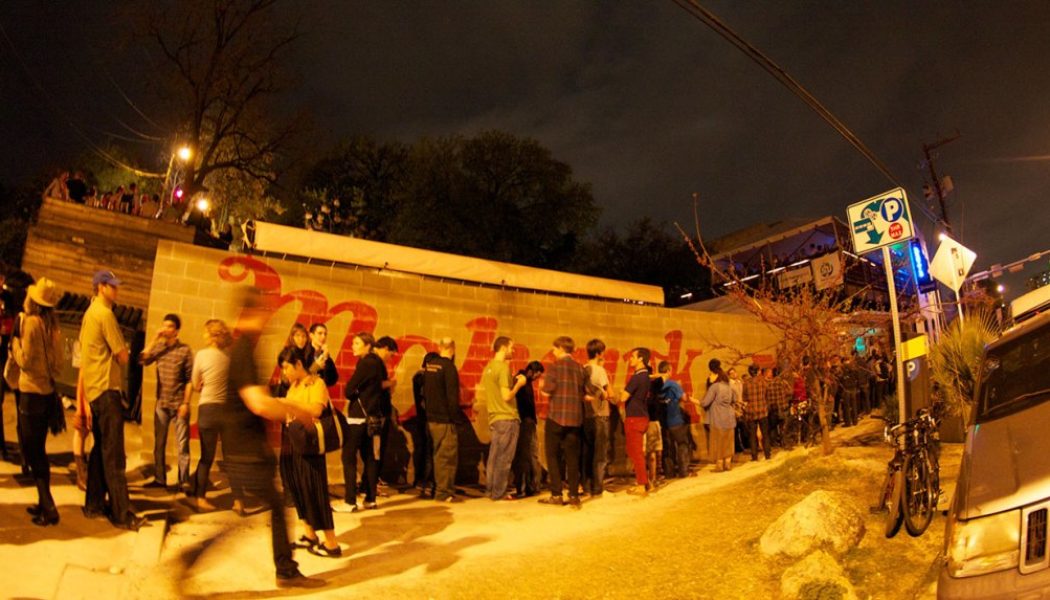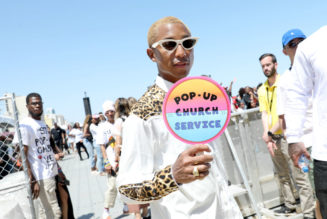
Austin’s success in the last decade as the so-called Live Music Capital of the World has come with a major drawback – the artists who call the city home have been the first ones priced out of the market. That paradigm might begin to change thanks to a non-profit group organized by Austin venue owners along the city’s famed Red River Street.
On March 18, members of the National Independent Venue Association flocked to one of those venues for a special happy hour toasting their survival and return to Austin after a two-year closure. Their host for the day, Empire Control Room owner and NIVA cofounder Stephen Sternschein and longtime colleague Cody Cowan, executive director of the Red River Cultural District, were on hand catching up with friends and discussing recent improvements to the area including sidewalk improvements, ADA ramp additions and some new landscaping and solar lighting. Cowan and Sternschein say momentum and public support for more ambitious projects to double the district’s size (which now runs from Waterloo Park to the Austin Convention Center) has never been stronger.
“Red River Street is home to the highest concentration of touring venues in the country,” says Cowan. Since the early 1990s the intersection of Sixth Street and Red River has served as the unofficial crossroads for South by Southwest, where the bars and restaurants of Sixth Street crossed paths with the venues of Red River. The intersection was home to Emo’s, Austin’s best rock club, and just a stone’s throw from important music venues like Stubb’s, Empire, Mohawk, the Chess Club, Valhalla and Cheer Up Charlies.
“There thing people have always loved about Red River is that you could go out for the night and easily go to two or three different concerts,” says Cowan, with venues ranging in capacity from a few dozen at Chess Club to 2,100 at Stubbs outdoor space. How Red River became the heavily trafficked home of a dozen venues is a historical fluke, Cowans notes — starting in the 1840s, for the first 100 years of its existence, it was Austin’s only main road that wasn’t uphill in either direction. Most of the clubs on the street started as post-WWII used furniture stores and antique shops, slowly transforming into a local entertainment destination in the 1970s that brought new visitors to Austin, along with new problems.
The Austin Chronicle described Red River in a popular 1996 oral history as an “odd bird” that had “done more to nurture original live music than Sixth Street or any other concentrated area in town.” As the piece noted, it was also home to high concentrations of “homeless people, winos, junkies, small-time criminals, and drug trafficking.”
Beginning in the mid-2000s, the greater Austin area was also experiencing a major population boom, growing 83%from 2000 to 2020 from 1.2 million to 2.3 million residents.
Initially many newcomers were graduates of the city’s University of Texas who decided to stay instead of returning to more conservative and energy-industry driven cities like Houston or Dallas. Young professionals from Los Angeles and New York were also moving to Austin, drawn to the promise of cheap real estate and no state income taxes. And former Govs. George W. Bush and Rick Perry actively courted private companies to relocate to the state with tax benefit programs like the 2002 Chapter 313 program, which amended part of the state’s property tax code to discount local school taxes for corporations and, according to the Texas Tribune using numbers provided by state comptroller’s office, resulted in $10.8 billion in tax savings for approximately 500 companies for energy companies and manufacturers including Samsung and Tesla.
That population growth, averaging about 35% each decade, pushed real estate prices up and increased demand for commercial development. Music businesses that could not cover the rent left, while others were evicted when their lease expired to make way for more profitable businesses.
“A lot of the landlords began realizing they could make a lot more money renting a Chipotle and a Sprint store than to a music venue,” says James Moody, owner of the Mohawk on the north end of Red River Street.
As Austin became more expensive, its residents produced creative ways to push back, including the “Keep Austin Weird” campaign started by a local librarian in 2002. When that didn’t work, Cowan said the Austin music scene doubled down on Gen X anti-commercial slacktivism and indifference, siloing off into a loosely connected federation of independently run venues. Red River doubled down on grime and cheap beers, Cowans said, “but eventually we realized we couldn’t keep things shitty enough to stop global economics.”
Red River Street was prime downtown real estate and developers were eager to offer property owners cash for their lots. What followed was a rash of closures at venues like Badlands, The Saxon Pub, Red 7 and Austin Music Hall.
Concerned about their future, venue owners who had never met or stepped inside their neighboring clubs launched a grassroots campaign in 2013 to lobby local and state officials for protection against gentrification. By 2015, venues like the Mohawk and Empire embraced the “Defend Red River” movement which led to the formation of the Red River Cultural District and a map of geographic boundaries of the district. Eventually a supportive City Council began developing policy and zoning restrictions in 2017 supporting the preservation and continued development of Austin’s music scene.
And then COVID-19 hit. On March 6, 2020, Austin officials canceled all live events right as the city was preparing to host what was expected to be the largest SXSW ever.
“We make the bulk of our money for the year during those two weeks,” said Moody who said he had more than $200,000 in Mohawk rental fees booked and was anticipating huge bar sales. All of it washed away as the state went into lockdown. Moody was forced to lay off his staff and began preparing for bankruptcy. A 2020 study by the Red River Cultural District estimate that Austin venues average about $40,000 in non-staff overhead each month.
Moody joined other members of the cultural district in supporting the newly formed National Independent Venues Association, which successfully lobbied Congress for passage of a bill that raised $15 billion in emergency relief aid for venues in December 2020. Moody says he was also offered a once-in-a-lifetime bridge loan from a wealthy individual who kept the Mohawk afloat while he waited for federal funds to come in. Moody did not want to identify the generous supporter, but Billboard has independently confirmed that it was Austin real estate tycoon Gary Keller who stepped in to help, offering similar support to other Austin venues. (Keller has been doing this since 2016 when he bought out the landlord for the city’s famed Saxon pub, preserving the singer-songwriter stage long celebrated for its finely tuned acoustics and family atmosphere.)
Red River Street venues received $10 million of the $54 million that was granted to Austin venues through the SVOG, according to records from the Small Business Association, which manages the awards. Another $20 million was allocated to live music from local grants and state grants.
“Venues that have never had more than $15,000 in the bank now have half a million dollars in the bank in prepaid rent,” says Moody. Now, he says, the back-to-back success staving off gentrification and the Shuttered Venue Operators Grant program has significantly increased the profile of the cultural district both in Austin and within the broader NIVA organization.
Cowan tells Billboard he plans to tap into the goodwill the district has created by lobbying for the passage of a first-of-its-kind local hotel occupancy tax for commercial artists, an effort he started pursuing in 2019. In Texas, hotel occupancy taxes for the arts tend to go only to non-profit groups “like the operas and ballets of the world,” says Cowan, “while live music gets boxed out because we’re seen as roughshod, tattooed entertainment sector of the working-class.” According to the Texas comptroller’s office, non-profits like the cultural district can legally allocate hotel funds if the money is spent supporting individuals and organizations that bring visitors to the state. Cowan is lobbying city officials to set aside $3 million to both directly subsidize local musicians and reimburse venues that book local acts.
Also on the agenda is a proposal to create a task force of Red River venue managers and residents to work closer with police to address issues of blight and vacancy that lead to crime in the area.
“The district likes to really approach this in terms of placemaking,” Cowan says. “Nature abhors a vacuum and crime tips to fill that gap for one reason or another.” Working with public safety and public works, Cowan says his group has been mapping out crime and unsafe incidents and then addressing the problems through tools like infrastructure enhancements, pedestrian visibility, code enforcement and when needed, outside land development.
“We want developers that can we partner with that will encourage sustainable growth that is compatible with our community,” he says.
The Red River Culture District is also working on efforts to provide equity pay for venue employees, diversity outreach to bring more groups into the live music community and national marketing and public relations campaigns based around Austin venues, artists and community members.
In 2020, the Red River Cultural District was recognized by the Texas Commission on the Arts as one of 51 official cultural districts in the Lone Star State, allowing it to apply for cultural funding from the commission and market individual businesses with the district to a national audience. For Cowan that means creating national campaigns bases around the venues and cultural organizations he supports.
The goal with many of these proposals, he says, is to influence other cities and arts- oriented groups to support similar initiatives aimed at protecting their cultural industries.
“The touring world is an ecosystem that depends on everyone’s survival,” Cowan says. “When one area fails, there’s no stop gaps in place and everything begins to fall like dominoes. In order to survive you have to be able to ensure everyone else is healthy.”
[flexi-common-toolbar] [flexi-form class=”flexi_form_style” title=”Submit to Flexi” name=”my_form” ajax=”true”][flexi-form-tag type=”post_title” class=”fl-input” title=”Title” value=”” required=”true”][flexi-form-tag type=”category” title=”Select category”][flexi-form-tag type=”tag” title=”Insert tag”][flexi-form-tag type=”article” class=”fl-textarea” title=”Description” ][flexi-form-tag type=”file” title=”Select file” required=”true”][flexi-form-tag type=”submit” name=”submit” value=”Submit Now”] [/flexi-form]










Tagged: Austin, business, entertainment blog, music blog, SXSW, Touring